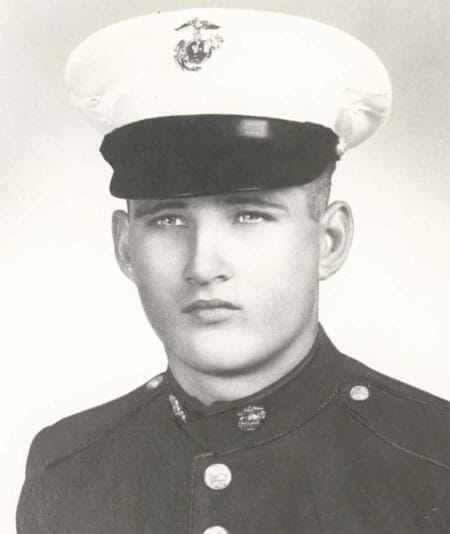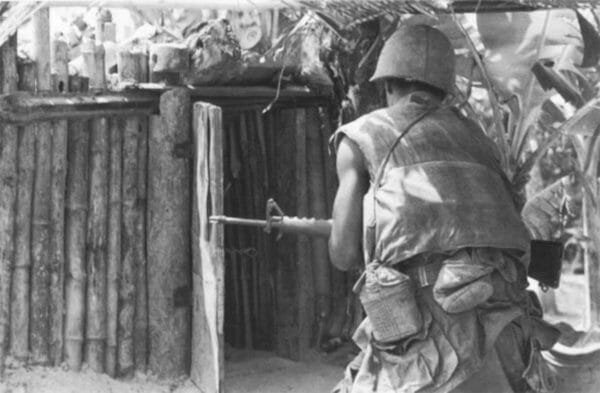By Katie Lange

USA – -(AmmoLand.com)- When you’re stuck in a bad situation, someone has to take the lead. That’s what Marine Corps Pfc. Robert C. Burke did in 1968 when his unit was pinned down by intense enemy fire in Vietnam. Burke didn’t make it out alive, but his actions earned him the Medal of Honor.
Burke was born Nov. 7, 1949, in Monticello, Illinois, and lived with his parents, four sisters, and two brothers. As a teen, he worked after school helping his dad build fences for area farmers. His mother told reporters later that he had dreamed of being a Marine since he was a young boy.

Burke made that dream a reality when he enlisted in the Marine Corps at 17 before graduating from Monticello High School in 1967. By the fall of that year, he had completed basic and individual combat training and earned the rank of private first class.
His first few months as a Marine were spent as a vehicle mechanic at Camp Pendleton in California. By February 1968, he joined the 3rd Battalion, 27th Marines, 1st Marine Division, as a machine gunner in Vietnam.
That spring, the Go Noi Island sector — about 15 miles south of Da Nang Air Base that housed U.S. troops — was considered a haven for the North Vietnamese Army and Viet Cong. By early May, the 7th Marines were tasked with going into that sector to prevent enemy troops from staging a new offensive.
Operation Allen Brook, as it was called, began May 4.
Third Battalion’s Company I, of which Burke was part, joined the fray later that month. Within days, their unit and several others successfully took over a major North Vietnamese supply staging area on the island.
On May 17, 1968, the group set out again in the early morning, with Company I in the lead. As Burke’s unit approached a dry riverbed near a dense line of trees bordering the small village of Le Nam, they were ambushed by a large force hidden in the tall grass and woods.
Fire from heavy mortars, rocket-propelled grenades, and automatic weapons exploded on them. Several men in Burke’s unit were injured, and some were killed, including its captain and two platoon leaders. The heavy enemy fire kept other units from being able to advance to help them.
Burke realized that key enemy points had to be taken out for them to advance and move their wounded. Without hesitating, he grabbed his machine gun and launched a series of one-man assaults against several enemy fortifications.

As he moved to the edge of the steep riverbank, he focused his assault on several enemy bunkers, which allowed his fellow Marines to move forward and get the wounded to relative safety. He then laid down heavy fire into an enemy position filled with automatic weapons, killing three North Vietnamese soldiers as they tried to get away.
Burke kept moving, systematically quieting the hostile fire until his weapon malfunctioned. He then grabbed a rifle and some hand grenades off someone nearby and kept fighting, taking out two more enemy soldiers.
When Burke saw that a fellow Marine had cleared his malfunctioning machine gun, he took it back and moved into an open position. He laid down a heavy line of fire along the trees until his injuries got the best of him. He died where he fell.
U.S. air and artillery support helped more Marines breakthrough to help the stranded unit, and, eventually, the enemy retreated. Fifteen men from Company I died and 50 more were wounded.
If it hadn’t been for Burke’s selfless actions, many more could have been lost.

The 18-year-old’s body was brought home and buried in Monticello Cemetery in his hometown.
After recommendations from his comrades and commanders, Burke became the youngest person from the Vietnam era to earn the Medal of Honor. It was presented to Burke’s entire family by Vice President Spiro Agnew on April 20, 1970, during a White House ceremony that honored several other Marines.
Burke’s sacrifice hasn’t been forgotten by the Marines or his hometown. Burke Hall, a recruit training facility at Marine Corps Recruit Depot San Diego, stands in his honor. In 1982, a park in his hometown was dedicated in his memory.
Burke’s Medal of Honor is on display with some of his other belongings in the Piatt County Courthouse in Illinois in what is now a shrine honoring him.
This article is part of a weekly series called “Medal of Honor Monday,” in which we highlight one of the more than 3,500 Medal of Honor recipients who have earned the U.S. military’s highest medal for valor.

U.S. Department of Defense
The Department of Defense provides the military forces needed to deter war and ensure our nation’s security. The foundational strength of the Department of Defense is the men and women who volunteer to serve our country and protect our freedoms. Visit www.defense.gov/ to learn more.
